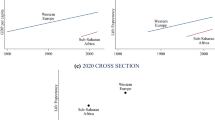Abstract
Between 1960 and 1970 blacks, as well as whites, improved their socioeconomic status. Among both races, educational attainment increased, the occupational distribution was upgraded, and real purchasing power rose markedly. In almost every comparison, the gains were somewhat greater among blacks than among whites and thus most indicators of racial differentiation declined. Nevertheless, the changes of this decade failed to eliminate racial differences with regard to socioeconomic status. In all comparisons, except for the income of certain groups of women, blacks were at a disadvantage when compared to whites both at the start and at the end of this decade, and very large racial differences remain. Further socioeconomic progress by blacks during the 1970s will probably not eliminate racial differences. The article concludes by relating the socioeconomic trends to such other aspects of race relations as integration, governmental policy, and the attitudes of whites and blacks.
Similar content being viewed by others
References
Bancroft, Gertrude. 1958. The American Labor Force. New York: John Wiley and Sons.
Blau, Peter M., and Otis Dudley Duncan. 1967. The American Occupational Structure. New York: John Wiley and Sons.
Bowen, William G., and T. Aldrich Finegan. 1969. The Economics of Labor Force Participation. Princeton: Princeton University Press.
Brink, William, and Louis Harris. 1967. Black and White. New York: Simon and Schuster.
Campbell, Angus, and Howard Schuman. 1968. Racial Attitudes in Fifteen American Cities. Ann Arbor: Survey Research Center, University of Michigan.
Clemence, Theodore G. 1967. Residential segregation in the mid-sixties. Demography 4:562–568.
Drake, St. Clair, and Horace R. Cayton. 1962. Black Metropolis (2 volumes). New York: Harper & Row. (Reprint ed.; original ed., 1945.)
DuBois, W. E. B. 1970. The Negro American Family. Cambridge: MIT Press. (Reprint ed.; original ed., 1909.)
Duncan, Otis Dudley. 1969. Inheritance of poverty or inheritance of race? In Daniel P. Moynihan (ed.), On Understanding Poverty: Perspectives from the Social Sciences. New York: Basic Books.
—, and Beverly Duncan. 1955. A methodological analysis of segregation indexes. American Sociological Review 20:210–217.
Farley, Reynolds, and Alma F. Taeuber. 1971. Racial segregation in the public schools. Unpublished manuscript.
Farley, Reynolds, and Alma F. Taeuber, and Karl E. Taeuber. 1968. Population trends and residential segregation since 1960. Science 159:953–956.
Fein, Rashi. 1965. An economic and social profile of the Negro American. Daedalus 94:815–846.
Frazier, E. Franklin. 1939. The Negro Family in the United States. Chicago: University of Chicago Press.
—. 1968. On Race Relations, ed. by S. Franklin Edwards. Chicago: University of Chicago Press.
Greeley, Andrew M., and Paul B. Sheatsley. 1971. Attitudes toward racial integration. Scientific American 225:13–19.
Miller, Herman P. 1964. Rich Man, Poor Man. New York: Thomas Crowell.
— 1966. Income Distribution in the United States. Washington, D. C.: Government Printing Office.
Myrdal, Gunnar. 1944. An American Dilemma (2 volumes), New York: Harper & Row.
Palmore, Erdman, and Frank J. Whittington. 1970. Differential trends toward equality between whites and nonwhites. Social Forces 49:108–117.
Pettigrew, Thomas F. 1964. A Profile of the Negro American. Princeton: Van Nostrand.
— 1971. Racially Separate or Together? New York: McGraw-Hill.
Price, Daniel O. 1969. Changing Characteristics of the Negro Population. Washington, D. C.: Government Printing Office.
Sheatsley, Paul B. 1966. White attitudes toward the Negro. Daedalus (Winter): 217–238.
Siegel, Paul M. 1965. On the cost of being a Negro. Sociological Inquiry 35:156–171.
U. S. Bureau of the Census. 1961. U. S. Census of Population: 1960. PC(l)-lB.
U. S. Bureau of the Census. 1963a. U. S. Census of Population: 1960. PC(l)-lD.
U. S. Bureau of the Census. 1963b. U. S. Census of Population: 1960. PC(2)-6A.
U. S. Bureau of the Census. 1967. Social and Economic Conditions of Negroes in the United States. Current Population Reports, Series P-23, No. 24 (October).
U. S. Bureau of the Census. 1970a. Income in 1969 of Families and Persons in the United States. Current Population Reports, Series P-60, No. 75 (December 14).
U. S. Bureau of the Census. 1970b. Household and Family Characteristics: March, 1969. Current Population Reports, Series P-20, No. 200 (May 8).
U. S. Bureau of the Census. 1970c. School Enrollment: October, 1969. Current Population Reports, Series P-20, No. 206 (October 5).
U. S. Bureau of the Census. 1970d. Twenty-four Million Americans, Poverty in the United States: 1969. Current Population Reports, Series P-60, No. 76 (December 16).
U. S. Bureau of the Census. 1971a. Marital Status and Family Status: March, 1970. Current Population Reports, Series P-20, No. 212 (February 1).
U. S. Bureau of the Census. 1971b. U. S. Census of Population: 1970. PHC(2).
U. S. Bureau of Labor Statistics. 1970. Handbook of Labor Statistics: 1970.
U. S. Bureau of Labor Statistics. 1971. Work Experience of the Population: 1969. Special Labor Force Report 127.
U. S. Commission on Civil Rights. 1967. Racial Isolation in the Public Schools. Washington, D. C.: Government Printing Office.
U. S. National Advisory Commission on Civil Disorders. 1968. Report of the National Advisory Commission on Civil Disorders. Washington, D. C.: Government Printing Office.
U. S. Office of Education. 1966. Equality of Educational Opportunity. Washington, D. C.: Government Printing Office.
Author information
Authors and Affiliations
Rights and permissions
About this article
Cite this article
Farley, R., Hermalin, A. The 1960s: A decade of progress for blacks?. Demography 9, 353–370 (1972). https://doi.org/10.2307/2060859
Issue Date:
DOI: https://doi.org/10.2307/2060859




